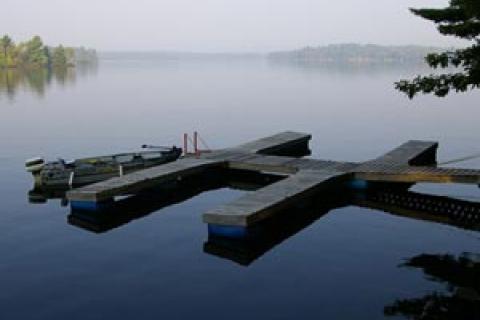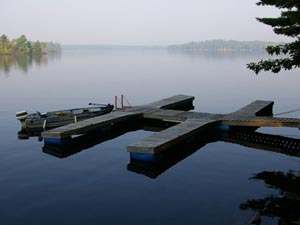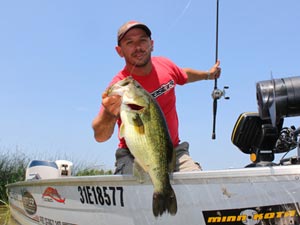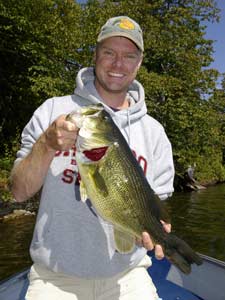
Dock fishing is a no-brainer when it comes to bass fishing. But how many of us routinely delve under the dark recesses of these man-made structures? Fishing docks is a sure-fire tactic for wrestling up these hide-and-go-seek largemouth that provides thrills for the eager angler. Knowing which docks to target and what to toss under them will give you the edge for increasing your proficiency — and help in increasing those catch rates. Give boat docks a try this season and capitalize on these lunker bass magnets.
![]() Watch Video: How to Fish a Dock for Bass - LINK
Watch Video: How to Fish a Dock for Bass - LINK
1. Not All Docks are Created Equal
Searching out the most productive boat docks on a lake — which will in turn attract the most bass — is the key to dock success. Docks are not created equal, although there are certain characteristics that will establish an ideal habitat and lure fish in. An important consideration is lead-in cover. Finding a dock with submerged vegetation surrounding and butting up to it will create an optimum ambush point, while also providing enhanced cover and safety. The same can be said for floating weed mats that have been blown into the dock.
These are a tremendous asset as they cut down on light penetration and also attract bait fish. This will bring in the predator bass. Wood, in the form of stumps or branches also seem to draw in heavier concentrations of largemouth, as it provides added cover and security.
Another consideration to heed when searching for docks is the material they are comprised of. Wooden docks that are old and weathered are your best choice as these are as close to a "natural" structure that bass will find. Docks in this state generally have a build-up of algae and other growths, which is extremely attractive to plankton and small organisms, which in turn will draw the bait fish and bass in.
 |
| These abundant, man-made structures will always have plenty of fish to be found. |
Seek out docks that are low to the waters surface. These will offer the most shade and are the most attractive to largemouth bass. Although metal and aluminum docks do hold fish, they will not be as consistent as a wooden one — that is unless the area is completely void of those of a more favorable material.
Another added bonus are docks with moored boats. A floating boat provides increased shade coverage and expands the area which bass can seek shelter under. Docks with adjoining boats can often hold a multitude of fish and are definite bass magnets when conditions are right.
2. Is There a Best Time?
Knowing when to fish docks is part and parcel of the equation. The formula is quite simple, and for the most part, revolves around weather conditions.
Bright sunlight and hot temperatures is a prime component for hitting up docks. I turn my attention to these man-made structures mid-morning under these ideal conditions, and if fish are present, stick with the pattern until mid to late afternoon. If fish are not showing themselves, in all likelihood they are in a transitional period, and your best bet is to wait an hour or so and come back.
Docks are an easy and quick structure to check for action. Finding, or not finding, fish will often clue you in to where they will be.
Another prime time to fish docks is during cold front conditions. Inactive fish will tuck under these structures and hold tight, waiting for the passage of the front. Fish can be hard to trigger during these down times, but repeated casts with precise presentations can elicit a strike from these sluggish and non-committal fish. The more severe of a front will see me increase my time I spend on each dock, dissecting every nook and cranny.
2. Your Approach
Boat control is a vital component for playing the dock game. Let's face it, bumping in to docks or getting too close will dramatically decrease your catch rate, not to mention raising the ire of cottagers.
 Always work in to the wind. This will allow you to control your approach precisely, as any small adjustments can be made easily with your electric motor. By taking this route, blowing by a dock too quickly or even into it, will be negated.
Always work in to the wind. This will allow you to control your approach precisely, as any small adjustments can be made easily with your electric motor. By taking this route, blowing by a dock too quickly or even into it, will be negated.
Keep your distance from the dock at all times — at least 10 feet. If the water you fish is clear and the fish finicky, then increasing the space between you and the fish should be considered.
Noise and vibration from your electric motor can spook and alert fish to your presence, so keep your setting on low and use it sparingly. A bow mount electric trolling motor is your best bet for dock fishing, as the maneuverability and ease of use far exceeds that of a transom unit.
Casting a shadow across the area you intend to fish should also be avoided, as should making loud noises or banging around in the boat. In terms of fishing the dock itself, there are a few rules to adhere to. Fish the structure closest to you first, which will most likely be the end of the dock. The most active fish will stage on the outside areas, so picking them off initially is advantageous. When fighting the fish to the boat, they have less likelihood of spooking other fish that are staging closer to shore. Once you have targeted the end area, work your way down each side until you reach the far recesses of the dock. If a boat is present, fish the prone side first before working the area between the craft and dock.
3. Fishing Equipment Considerations
Flipping gear is the route to go for most dock situations. This rugged tackle will allow you to horse fish out and away from docks with ease, minimizing break offs and lost fish. Choose a 7-foot, 6-inch heavy action flipping stick and high ratio baitcast reel, teamed with 20-pound monofilament, fluorocarbon or braid equivalent.
Flipping or pitching your baits will allow you to make precise casts, with little to no splash. This is ideal for dock fishing. Flipping jigs make up the brunt of my dock arsenal, but I also rely on creature baits, tubes, soft stick baits and cranks. Crankbaits (as well as spinnerbaits and swimbaits) are great lures for when bass are holding on the outside edge of docks, especially during mid-morning and evening periods. They are an excellent "search" bait to toss before slowing down and delving into the more shaded areas with vertical offerings.
When pitching flipping jigs, allow your bait to sink down on a controlled line. If a strike doesn't occur on the original fall, shake it in place for 10 seconds or so before slowly swimming it back to the boat. Repeated casts may be necessary for fish that are skittish. Ensure that you work the entire dock, as the difference in a foot or two can make a difference when it comes to getting bit.
 Skipping docks is a relatively new technique that allows an angler to target areas that are virtually impossible with regular casting tactics. Similar to skipping a pebble, short (generally 6-foot) but stout spinning rods are used to propel a downsized bait under and to the back of docks. Using specialized jig heads with a planed surface, in conjunction with craws, tubes, or creature baits, rounds out the presentation. Although it does take some practice, and the reliance on the correct equipment, once mastered it can unearth fish that were once thought to be untouchable. Definitely worth a look.
Skipping docks is a relatively new technique that allows an angler to target areas that are virtually impossible with regular casting tactics. Similar to skipping a pebble, short (generally 6-foot) but stout spinning rods are used to propel a downsized bait under and to the back of docks. Using specialized jig heads with a planed surface, in conjunction with craws, tubes, or creature baits, rounds out the presentation. Although it does take some practice, and the reliance on the correct equipment, once mastered it can unearth fish that were once thought to be untouchable. Definitely worth a look.
Whatever tactic you embrace, if fish are aggressive stick with heavier baits with a faster drop — for finicky fish, lighten up your presentation. Colors vary, but I like to stick with natural hues for clear water conditions, and brighten things up when the water is dirty. Applying scent and utilizing baits with rattles will often account for extra fish.
4. Boat Dock Etiquette
Fishing docks is a fun tactic to tackle, but a few rules should be followed. If families are on a dock or moored boat, simply move on to the next. This is the most considerate thing to do, especially since most shorelines will have dozens more to choose from.
Control of your casts is paramount. Hitting boats, snagging ropes or tangling baits around dock posts is not only reckless, but can pose a danger to swimmers. If you do happen to snag some property, do the right thing and retrieve your bait.
Give docks a try this season and see what all the fuss is about. These abundant, man-made structures will always hold fish, and if you put in the time to fish them correctly, you will reap the rewards that these hidden fish can provide.
- 11984 views

